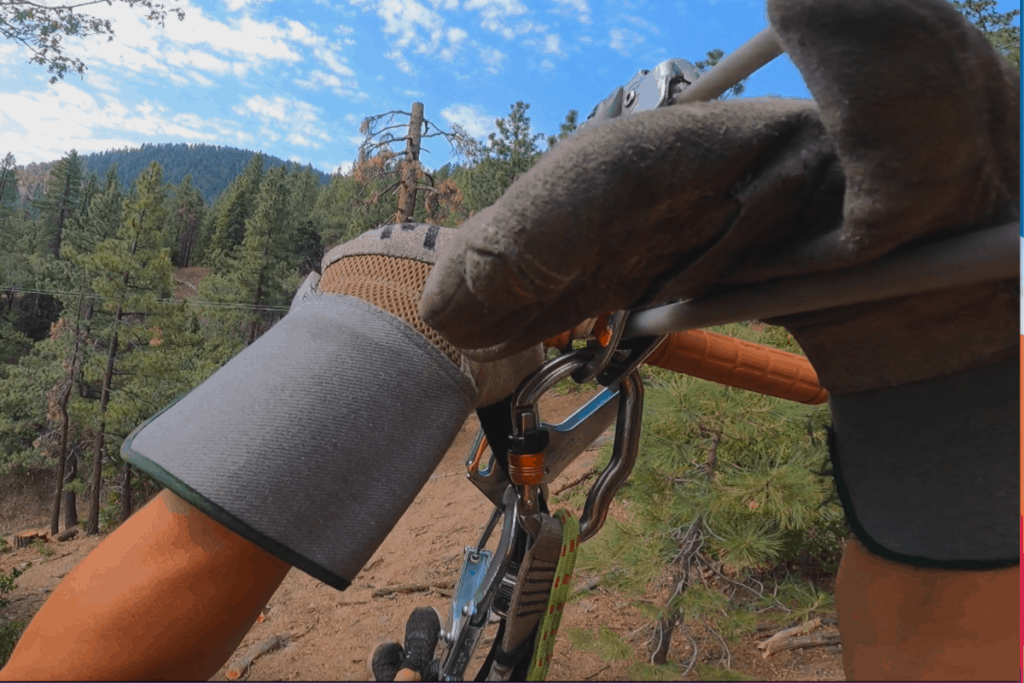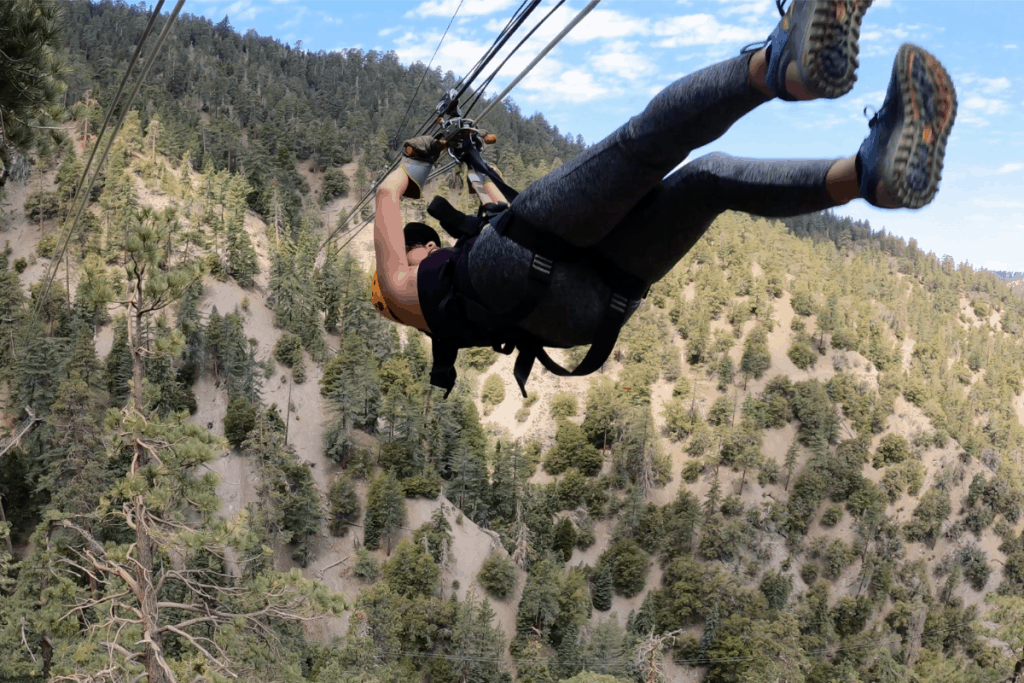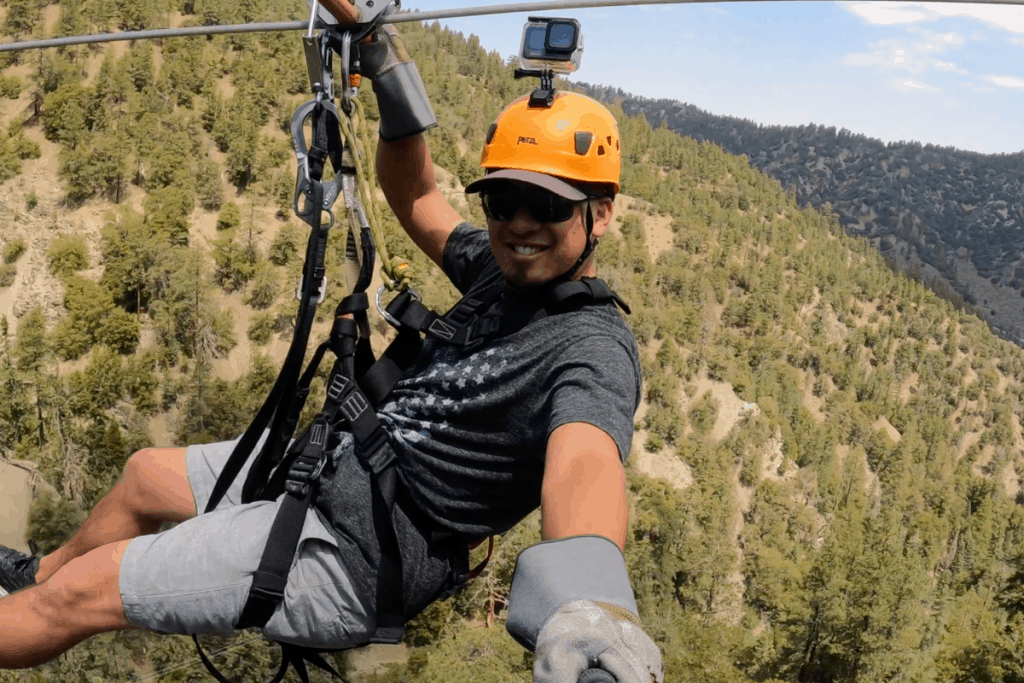This is it, the day when you go ziplining for the very first time. You want it to be an exciting, enjoyable, and safe experience for you and your whole family. What should you know before you go?
Check out my latest Zipline video from Zipline at Pacific Crest to see what type of experience you can expect!
Here are some helpful pointers ahead of your first zipline ride:
- It’s fast, but not dangerously fast
- You will know how to stop
- You should wear bug repellent and sunscreen unless indoors
- People of almost any age and skill level can zipline
- There is a weight limit
- You should eat before you leave
- Empty pockets are a must
- It’s on you to dress for the weather
- Ziplining is safe
In this article, we’ll discuss the above tips in more detail so you’ll feel more than prepared for a successful and fun first zipline experience! You won’t want to miss it.
Here are 9 Things to Know Before Your First Zipline Ride
It’s Fast, but Not Dangerously Fast
Just how fast does a zipline go? We wrote about that in this post, which we certainly recommend you read before you go ziplining for the first time (if you haven’t already read it).
The average zip line speed is around 20 to 40 miles per hour. Some zip line courses are moderately faster at 50 MPH. Unless it’s a zipline that’s trying to beat speed and altitude records though, those speeds are the norm.
The slope and length of the zipline cable are two of the main determining factors of your speed. How much you weigh–which we’ll talk about a little later–also impacts your terminal velocity. Lightweight riders like children will not go as fast as adults since they weigh more. That’s true even if the zipline course and all the conditions are otherwise identical.
This is good news for any concerned parent whose kids have been hounding them to go ziplining for months now. You won’t have to stress about your kids racing down the course too quickly. If you’ve allowed them to ride roller coasters at a theme park before, those amusement rides are faster than ziplining.
Trust us when we say that ziplining is never boring, especially at commercial courses. You and the kids will have a blast!
You Will Know How to Stop

Perhaps one area of trepidation around ziplining is how you’ll stop. Once again, we refer you to our article on ziplining speed, as we talked about active and passive brakes in detail. We’ll recap the information for you here.
Active brakes are far less common, especially at today’s ziplining courses. That’s due to how active braking requires the rider to stop themselves using a brake box or a glove. Yes, you’d put a glove on your hand and then press the zipline cable to slow your speed and come to a stop.
If that doesn’t sound very safe, that’s because it isn’t. You can forget to press the line or miss your cue and press it too late, possibly crashing and hurting yourself. Even the act of stopping with active brakes can be injurious, which is something we’ve talked about a lot on this blog. One thing to keep in mind is your guide will most likely have an active break they can pull to help reduce your speed. You most likely won’t hit a tree but you will get tossed around a bit.

Passive brakes stop you automatically at the end of your zipline ride so you don’t have to do a thing. Magnetic brakes are among the most economical passive brakes since they’re built with fewer parts that need less downtime. Gravity brakes with a slope can bring you to a stop when needed, as can spring brakes with coils inside.
Whether your zipline course has active or passive brakes, you’ll know ahead of time. Don’t feel like you have to be a zip line brake expert before you arrive at the course. Part of your zipline tour is for training and orientation. The zipline crew will teach you everything you need to know for a safe ride.
You Should Wear Bug Repellent and Sunscreen Unless Indoors
Most zipline courses are outdoors. Whether you’re encircled by dense forest, gorgeous beaches, or icy tundra, drinking in your location is one of the best parts of ziplining by far!
Yet being outdoors also means you need to protect your skin. We’d recommend bug repellent so you don’t have to worry about being bitten by whatever insects populate the area, from mosquitoes to horseflies.
You also need sunscreen. Zipline rides last between 60 and 180 minutes, sometimes longer. This includes your arrival, orientation, training, and the zipline ride itself, but that’s a lot of time in the sun all at once. When your zipline ride is over, you don’t need a souvenir in the form of a painful sunburn!
People of Almost Any Age and Skill Level Can Zipline
If you have young kids especially, you might be concerned that they wouldn’t be allowed on the zipline course. While very young kids usually aren’t eligible to ride, if your child is about seven years old and you ride with them, then they’re permitted. That’s usually true until the child is 10.
For children who are between 12 and 15 years old, an adult doesn’t have to ride with them, but they do have to be there on the premises. Once your kids are older than 15, they can ride a zipline course completely unsupervised.
These rules vary from one commercial zipline course to another, of course. We recommend calling the company if the age policy isn’t clear on their website.
What about older adults who might be interested in zip lining such as grandparents? If you’re otherwise healthy, then there’s no reason you couldn’t go zip lining even in your senior years.
Do you have to be ripped with six-pack abs to zipline? Not at all! While weight limits exist for riders, which we’ll get to in just a moment, if you’re not athletically inclined, you can still ride.
This inclusivity makes ziplining a very family-friendly activity.
There Is a Weight Limit
Okay, let’s discuss the weight limit now. Most zip line courses mandate that their customers weigh at least 60 pounds. Thus, while some companies might have an age limit, a weight limit is more common.
If a five-year-old kid weighs 62 pounds, then even though they’re young, they might be allowed to ride the zipline course. Well, with a parent’s consent.
The weight cutoff might be around 265 or 300 pounds, but it’s rarely higher than that. Zipline cables can only handle so much strain before they risk fraying. This impacts the safety of not only the current rider but any other riders who are scheduled to use the course that day as well.
In some instances, your waist circumference might be measured too, with limitations on waist size. This can seem offensive to some people, but you have to remember that these weight rules exist so ziplining can be a safe experience for everyone.
You Should Eat Before You Leave
Here’s something that doesn’t come up much when you’re prepping your outfit and deciding where to strap your GoPro to get the best angle of your zipline ride. What will you eat? Zipline courses might fill you to the brim with entertainment and excitement, but food? Not so much.
If your zipline tour is only an hour, then you can probably forego the food. Since we can bet you’re feeling nervous about your zipline ride, you’ll be glad to know that you don’t have to force something down that could make you nauseous later.
For zipline tours longer than an hour and especially for those that are three hours, you might want to consider nibbling on something before you leave the house or hotel. You don’t want anything to detract from the most fun moment of the tour–when you finally get to ride the zipline–and a rumbly tummy can be very distracting.
Even if you don’t feel like eating before your ride, please make sure you hydrate yourself. Hours out in the hot sun will make you sweat, and that causes electrolyte loss. Water alone can’t replenish those electrolytes, so drink a sports beverage too.
Empty Pockets Are a Must
Although a zipline doesn’t flip you upside down like a roller coaster does, the speed and the downward trajectory of your ride don’t make it a good idea to carry anything valuable in your pockets. Put your car keys, your wallet, and especially your phone in a waist bag or fanny pack. Even loose change should go elsewhere.
Speaking of your phone, many zipline companies advise you not to have it out during the ride. If you want to capture priceless memories of the zipline experience, you can pay for a photo or video package through the zipline company. You can also bring a GoPro that you can strap to your head or body so it doesn’t go flying.
It’s on You to Dress for the Weather
The crew at the zipline company will outfit you in a harness and attach you to the zip line cable, but you’re expected to be dressed to ride upon your arrival. That begs the question then, what do you wear when ziplining?
Athletic clothes are a safe bet. You want to be flexible as you ascend the zipline course and step off the main platform.
Yet you also have to dress for the weather. If it’s cold, then layer up. Avoid wearing cotton as your base layer. If you get sweaty, cotton doesn’t absorb sweat, so all that perspiration will be on your skin.
Summertime zipline rides are very popular, but please don’t dress like it’s a day on the beach. Women, avoid skirts or dresses and wear athletic shorts or pants instead. Men, skip the cargo shorts, as they’re a bit too baggy.
Most important, put on a pair of closed-toe shoes. Sandals and flip-flops will fly off your feet as you descend the zip line cable, never to be seen again.
Ziplining Is Safe

The last point we want to stress is this: ziplining is a perfectly safe activity for kids, adults, and seniors. As we wrote about here, in the period from 1997 to 2012, only 3,600 riders were injured on zipline courses.
Even when hurt, most injured zip line riders were able to walk away of their own volition. Roughly 12 percent of zipline riders go to the hospital after an injury.
From 2006 to 2016, up to 16 people died when ziplining, mostly from falls but also from material failure, collisions, and entanglements. Although we don’t know as much about zip line death data as we do injury stats, the number of deaths seems to be relatively low.
We can’t ignore the disturbing trend that zipline injuries are on the rise, but ziplining is a much safer activity than some of the things you do every single day. For example, each time you get in your car and drive, your chances of being in an accident are much higher than being hurt while ziplining.
If you ride an elevator at work, that’s more injurious than zip lining too. Even using a vending machine poses more dangers, which says a lot about how safe zip lining is!
Final Thoughts
Ziplining can foster family togetherness, but before your first ride, it helps to know as much about what you’re in for as you can. Check the zipline course’s weight limit, have something to eat, dress appropriately, empty your pockets, and put on sunscreen. You’ll be sure to have an amazing time!
